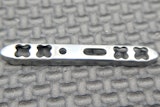As the FIRST robotics competition kicks into full swing, teenagers are diligently stewing over mobility and sensor issues, finding funds for an ever shrinking budget, and preparing for the world’s biggest robotics contest. This year’s FRC (FIRST Robotics Competition) game is called "Rebound Rumble," and it has what every engineer desire: many problems to solve.
This year the playing/operations field is designed similar to a 27’ x 50’ basketball court with four hoops at each end. A low barrier extends across the middle of the court with three rocking bridges. Teams are required to make alliances with other teams as they progress through the game. Three teams form an alliance on either side of the court.
As with every FRC game, the competition has three main phases:
- The Hybrid Phase: This phase requires the robots to be operated independently of a human controller. Utilizing reflective vision targets above the hoops, robots use preprogrammed instructions to score points. A new twist has been put on this year’s game. One alliance team member can control their robot using a Kinect Motion Sensor during this period.
- The Tele-Operated Phase: Teams command their robots with controllers to score baskets as quickly as possible. Robots can score from anywhere on the court, and, aside from a protected area, can defend the hoops as well. Hoops for each team are opposite their operating position, so robots must cross the center barrier or use a bridge to get closer for scoring.
- The End Phase: At the end of the match, teams will attempt to balance their robots on the bridges. Each bridge can barely fit three robots, but more balanced robots will mean more points. During qualification matches, both alliances earn cooperation points if they work together to have opposing robots balanced on the center bridge.
This year a heavy emphasis will be put on cooperation as these points affect seeding throughout the tournament. ‘Gracious professionalism,’ as the FIRST values accentuate, will be essential for FRC success. Another term coined by FIRST, ‘Coopertition: the displaying of unqualified kindness and respect in the face of fierce competition,’ will also play a vital role in this year’s game.
We had the chance to catch up with FIRST founder, Dean Kamen, and ask him about the 2012 competitions:
PD&D: What do you feel is the most significant reason behind the growth FIRST has experienced over the years?
Dean Kamen: All of the stakeholders involved with FIRST have realized that they get far more out of the program than they put in. From the kids, parents, teachers, and mentors who participate, to the corporations, foundations, and government agencies who sponsor us, to the fans who have the chance to see creativity and competition on an incredible scale, everyone who is involved with FIRST has realized its importance and how effectively it inspires a new generation of technology leaders and innovators.
PD&D: If you were to compare the average student who was involved with the initial FIRST competition in 1992 with the average student involved today, what do you feel would be the main differences?
Dean Kamen: I am pleased that some things never change. We continue to bring in new groups of students who are unaware of the accessibility and fun associated with developing skills around science and technology, and they always leave with self-confidence, teamwork skills, and a new perspective.
PD&D: What types of progressions do you see as students move throughout the different levels of FIRST competition?
Dean Kamen: At each level in the FIRST Progression of Programs — from kindergarten through high school — the technology becomes more sophisticated, and so do the kids.
PD&D: Where does the development for the games come from? Would you consider the FRC games and FTC games to be getting progressively harder over the years?
Dean Kamen: The games are developed by a brilliant team of internal FIRST staff and volunteers. I wouldn’t say that the games have gotten harder, but as technology advances so do our games and the kids’ designs. For example, this year in the FIRST Robotics Competition, one of our two high-school robotics programs, is using Microsoft’s Kinect technology. This could not have happened in 1992.
PD&D: The mission of FIRST is to inspire young people to be science and technology leaders, you’re clearly achieving that goal, so what can we expect from FIRST in the future?
Dean Kamen: We will continue to grow FIRST until it is available to every student in this country, and they realize that the only way to become a real ‘pro’ is to learn the skills needed for the 21st century.























